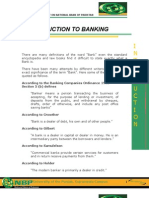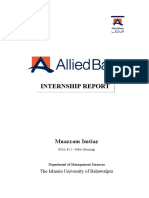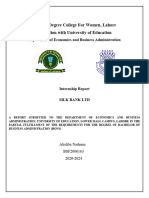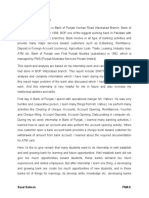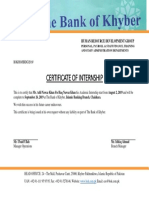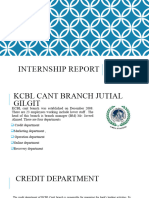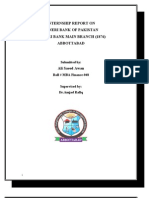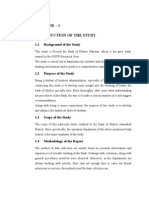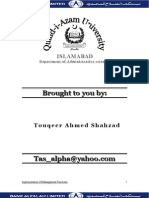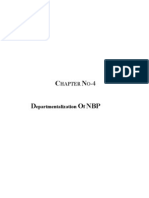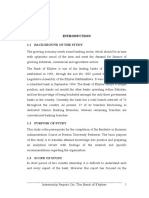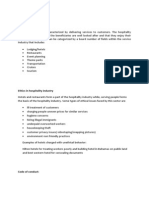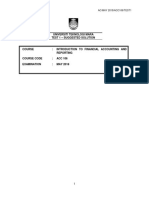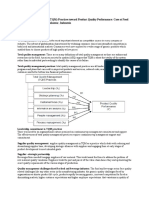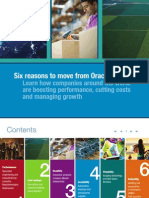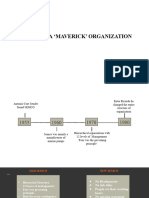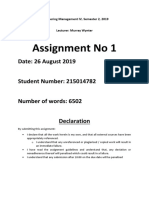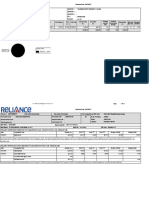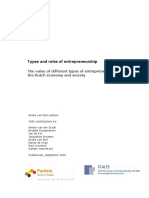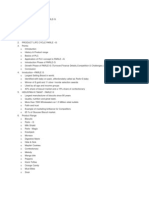Chapter # 1: 1.1 Study Background
Uploaded by
samreen kChapter # 1: 1.1 Study Background
Uploaded by
samreen kInternship Report of The Bank Azad Jammu & Kashmir 1
CHAPTER # 1
INTRODUCTION
1.1 Study Background
Today, banks are the most important financial institutions which play a vital
role throughout the world’s economic system. Because most of the sectors like
Industries, Commerce and Agriculture need financial assistance, it is the banks
which carefully entertain them.
There are different views about the origin of the word “Bank”. Some authors
opine that the word “Bank” is derived from the word “Bancus” or “Banque” which
means a “Bench”. They support this origin by the argument that Jews merchants in
Lombardy transacted their business of money exchange on the benches in market
places. If the money of any businessman failed his bench was destroyed by the
people. Due to this practice the word “Bankrupt” was also used. On the other hand
some people say that the word “Bank” is derived from German word “Back” which
means joint stock fund. Later on, when the Germans occupied major part of Italy, the
word “Back” was Italianized into Bank.
An opportunity was created to understand the practical banking operations
during job in The Bank of Azad Jammu & Kashmir. This report is about the general
workings of the branch.
1.2 Why is the Study Conducted?
This study is the requirement not only for the completion of a M.com (Two
Years) degree, but also for acquiring some professionalism in an organization, so
that one can understand the actual practices of transactions and the business of
banks. In this manner interns, are given a chance to spend time in different
departments/sections of bank and learn to do actual banking transactions which
have already been studied previously. Moreover, it is also required to analyze
different aspects of the organization and to forward suggestions to put right
problems, which are being faced by the banks- if possible.
By: Abdul Ghafoor Chughtai M.com (Ghafoorchughtai77@gmail.com) 03005045011
Internship Report of The Bank Azad Jammu & Kashmir 2
1.3 Scope of Study
This report may help students in future to understand banking practices in
our country. It would also attempt to evaluate the overall performance of The
BOAJK through a thorough & detailed analysis of its daily working.
1.4 Methodology of Study
For the purpose of writing this report, the following methods of collecting
information have been used:
1.4.1 Primary Data
The information, which is collected for the first time and exists in raw form,
is known as Primary Data. It contains the following:
a) Personal observations
b) Discussion with staff of the BOAJK.
1.4.2 Secondary Data
The information, which has undergone through statistical techniques and
exists in a refined form, is known as secondary data. It contains the following:
a) Annual Report: Annual report of The BOAJK, issued by the management for
the years 2013 and 2014.
b) Information memorandums: Various information memorandums issued by
the management and HR division for the information of the Clients and Staff.
c) Internet: Internet is used to get updated information from the official website
of the Bank as well as other web based information available.
d) Documents published by banks: Various documents and Broachers printed by
the commercial banks for their clients.
e) Banking manuals: Different kind of manuals issued by banking operation
division for various departments.
By: Abdul Ghafoor Chughtai M.com (Ghafoorchughtai77@gmail.com) 03005045011
Internship Report of The Bank Azad Jammu & Kashmir 3
CHAPTER # 2
BANKING SECTOR IN PAKISTAN
2.1 Definition of Bank
According to Chambers English Dictionary1, the term “Bank” means a
“bench” or institution or an exchange company. Caircross defines bank as a
financial intermediary and a dealer to create credits. Some authors are of the
opinion that the word ‘Bank’ is derived from the German word ‘Back’ which
means ‘joint stock fund’. Later on, when the Germans occupied a major part of
Italy, the word ‘Back’ was Italianized into ‘Bank’. Different authors have given
different opinion but according to section 5 (b & c) of the Banking Companies
Ordinance 1962 “Banking means the accepting ,for the purpose of lending or
investment, of deposits of money from the public, repayable on demand or
otherwise, and withdraw-able by cheques, drafts, order or otherwise.” Where as
banking company means any company, which transacts the business of banking in
Pakistan.
2.2 Functions of Bank:
According to section 7 of the BCO, 1962, the banks in Pakistan are
authorized to engage in any one or more of the following forms of business,
namely:
The borrowing, raising or taking up of money;
The lending or advancing of money either upon or without security;
The drawing, making, accepting, discounting, buying, selling, collecting
and dealing in bills of exchange , promissory notes, drafts, bills of lading
warrants, debentures(musharika and mudaraba certificates);
The granting and issuing of letters of credit, travelers’ cheque and circular
notes;
The buying and selling of foreign exchange including foreign bank notes;
By: Abdul Ghafoor Chughtai M.com (Ghafoorchughtai77@gmail.com) 03005045011
Internship Report of The Bank Azad Jammu & Kashmir 4
The acquiring, holding, issuing on commission, underwriting and dealing
in stock fund, share debenture stock, bonds, obligations, securities;
The receiving of all kinds of bonds, scripts or valuables on deposit or for
safe custody or otherwise, the providing of safe deposit vaults, the
collecting and transmitting of money and securities.
Acting as agents for any government or local authority or any other person
or persons;
Acting as “Mudaraba company” under the provisions of the Mudaraba
Companies Ordinance 1980;
Contracting for public and private loans and negotiating and issuing the
same;
The effecting ,insuring, guaranteeing, underwriting, participating in
managing and carrying out of any issue, public and private, government,
municipal, or other loans or of shares, stock, debentures or debenture stock
of any company, corporation or association and the lending of money for
the purpose of any such issue;
Carrying on and transacting every kind of guarantee and indemnity
business;
Purchase or acquisition in the normal course of its banking business of any
property, including commodities, patents, designs, trade-marks, and copy
rights, with or without buy-back arrangements by the seller, or for sale in
the form of hire-purchase or on deferred payment basis with markup or for
leasing or licensing or for rent-sharing or for any other mode of financing;
Managing, selling and realizing any property which may come into the
possession of the company in satisfaction or part satisfaction of any of its
claims.
By: Abdul Ghafoor Chughtai M.com (Ghafoorchughtai77@gmail.com) 03005045011
Internship Report of The Bank Azad Jammu & Kashmir 5
2.3 Establishment of Banking Sector in Pakistan
Prior to pre-partition the entire banking sector was dominated by the
Hindus which created a great financial vacuum after the shifting of their business
to India (post-partition). Our great leader, the founder of Pakistan, Mohammad Ali
Jinnah, had at that critical period, accepted this challenge with faith and confidence
on Almighty Allah and decided to continue with his mission. At the time of
independence there were 487 offices of scheduled banks, out of which only 197
were left over to Pakistan because of Hindu domination over the banks. There were
19 non- Indian foreign banks with the status of small branch offices, which were
engaged solely in the export of crops from Pakistan, and there were only two other
Pakistani institutions, i.e. Habib Bank and Australasia Bank. The panic of an
uncertain future shook the confidence of the people. In response, the govt,
therefore, promulgated the Banking Companies Ordinance 1947 to safeguard the
interest of both the bankers and the customers. Meanwhile, the Imperial Bank of
India, which had been acting as the agent of Reserve Bank of India closed down
most of its offices in Pakistan and also was not willing to purchase even, token
amounts of Government of Pakistan securities. The Indian government withheld
Pakistan’s share of rupees 75 crores in cash balances held by them at the time of
partition. Because there was an urgency of assuming control of banking and
currency in Pakistan, in 1947, an expert committee was appointed to deal with this
major issue. This committee recommended that the Reserve Bank of India would
continue its function in Pakistan. Consequently, SBP was established on July 1 st,
1948. The SBP assumed full control of banking and currency in Pakistan. The first
Pakistani note was issued in October, 1948, in the denomination of Rs. 5, 10 &
100.
Following this, the SBP decided to expand the network of Habib Bank and
recommended to the government to establish an agent of SBP. As a result, the NBP
came into being in 1949 and in the year 1952 it took over the agency function.
As a result of the outbreak of the Korean War in 1950, a great boost was
provided for Pakistan’s exports and thus the demand for banks, advances increased
sharply. However, with the end of the Korean War 1952, there was a short fall in
the country’s export earnings with no appreciable change in its imports. This
naturally caused a drain on the Foreign Exchange Reserves and in turn affected the
By: Abdul Ghafoor Chughtai M.com (Ghafoorchughtai77@gmail.com) 03005045011
Internship Report of The Bank Azad Jammu & Kashmir 6
balance of payment position. Consequently, this induced banks to provide working
capital for industries & as a result SBP sponsored the setting up of an Industrial
Finance Corporation.
In the period of 1956-58 further expansion in the banking & credit facilities
resulted in the establishment of two more banks; The National Commercial Bank
Ltd and the Pakistan Industrial Credit and Investment Corporation (PICIC). 1959-
66 saw the establishment of two more Pakistani banks, i-e the Eastern Mercantile
Bank Ltd and United Bank Ltd. Another very significant event in the development
of banking in Pakistan was the appointment of the Credit Enquiry Commission in
1959 to examine the scope and working of the institutions providing credit
facilities in agriculture, trade, commerce and industry and to recommend measures
for further improvements in the field of banking. In 1960 the Rural Credit Fund
was also setup with an appropriation of Rupees one crore to provide medium and
long term credits in the rural areas. In the hope that banking would enter into a new
era of further development and progress, Pakistani commercial banks were
nationalized in Pakistan from January1, 1974. However, it was later realized that
this tip proved to be counter productive; hence, a reversal has been initiated since
January 1991. By June 1997, more than 7000 branches of the above mentioned
banks were expanded and mobilized more than Rs. 887.000 billion in deposits and
provided finance to various sectors amounting more than Rs. 548,000 million.
Over the years some specialized credit and financial institutions have also
developed like the National Investment Trust (NIT), the People Finance
Corporation, the Equity Participation Fund & the National Development Finance
Corporation & the Small Business Finance Corporation, to name a few, all of
which are contributing their due share in the country’s economic life.
2.4 Birth of the Bank of Azad Jammu & Kashmir
Keeping in view the long desire of the people of Azad State of Jammu &
Kashmir having a financial institution with in the state, the Government of Azad
Jammu & Kashmir started working for establishment a financial institution in 1974;
however, the idea could not be grownup. However, in 2005, then the Government
started working on the idea with great zeal. For the purpose, expertise of Mr.
Muhammad Ahsan, former chairman of Pakistan Banking Council and Mr. Masaud
By: Abdul Ghafoor Chughtai M.com (Ghafoorchughtai77@gmail.com) 03005045011
Internship Report of The Bank Azad Jammu & Kashmir 7
Ahmed Sheikh (late), former Deputy Chief Executive, The Bank of Punjab was hired
who started working on the project.
Gnawed nationally and globally as a house hold name for market competitive
products and efficient as well friendly services.
By: Abdul Ghafoor Chughtai M.com (Ghafoorchughtai77@gmail.com) 03005045011
Internship Report of The Bank Azad Jammu & Kashmir 8
Vision:
To be the premier financial institution, recognized nationally and
globally as a house hold name for market competitive products and efficient
as well friendly services.
Mission:
To develop and maintain a committed professional team trough a
challenging and rewarding working environment that leads the Bank to the
status of a premier financial institution.
To create sustainable value through growth, efficiency and diversity for
all stake holders, and to play a proactive role towards the socio-economic
development of the state.
Core Values:
Highest quality of services
Professionalism
Integrity
Team work
Innovation & utilization of latest technology
Corporate & social responsibility
By: Abdul Ghafoor Chughtai M.com (Ghafoorchughtai77@gmail.com) 03005045011
Internship Report of The Bank Azad Jammu & Kashmir 9
CHAPTER # 3
ORGANIZATIONAL STRUCTURE
Organization is defined as a system in which individuals and groups
operating at different levels perform the task assigned to them within the
framework of delegated authority and responsibility which are rationally
coordinated to achieve the desired organizational goals.
Organization makes management easier, effective and result oriented. An
organization designed and structured on planned lines promotes collaboration and
negotiation among individuals in a group and thus improves the effectiveness and
efficiency of communication within the organization. This function creates clear
cut lines of authority and responsibility in the organization.
The word “Organization” has two meanings, firstly, it means an institution
or structure, viz. a bank is an institution with its organizational structure of Head
Office, local office, district offices and branches. Secondly, it means a process of
an ongoing activity i.e., the process of organizing, locating and bringing about
relationships among men, money and services. In fact organization establishes
relationships among the people so that they collectively contribute to the
attainment of organizational goals effectively. Thus organization is a means to an
end. It is also an important part of management.
Similarly, organizational structure or hierarchy of a firm provides
boundaries for authority of persons which further clarifies responsibility and the
scope of authority. Basically, it shows who is responsible to whom and who has the
authority to give orders to someone. Actually these are the tools by which a manger
is able to exercise discretion and create an environment for individual
performance.
The organizational structure of The BOAJK also has some specific aims
and objectives. In The BOAJK, all the structural procedures and systems are
designed to serve customers of the BOAJK in the best possible manner. The
BOAJK is governed by a board of directors, consisting of five members, in which
By: Abdul Ghafoor Chughtai M.com (Ghafoorchughtai77@gmail.com) 03005045011
Internship Report of The Bank Azad Jammu & Kashmir 10
the Managing Director of the BOAJK may also hold the position of a Chairman of
the Board.
3.1 The BOAJK’s Organogram
By: Abdul Ghafoor Chughtai M.com (Ghafoorchughtai77@gmail.com) 03005045011
Internship Report of The Bank Azad Jammu & Kashmir 11
The Network of Branches
The BOAJK has a network of 42 branches, which are located in different
areas of Azad Kashmir. In order to strengthen the operation network in the country,
the management is planning to open new branches at important cities and
locations.
Branch Name Address
Main Branch Muzaffarabad Bank Square, Chattar, Muzaffarabad
Main Branch Mirpur Chowk Shaheedan Mirpur
Dadyal Branch Maqbool Butt Shaheed Chowk, Dadyal
Chaksawari Branch Opposite Al-Shahzad Hotel Chaksawari
Kotli Branch Poonch / Rawalpindi Road Kotli
Rawalakot Branch Gulf Shopping Complex Katchary Road Rawalakot
Sehnsa Branch Main Bazar Sehnsa AJK
Athmuqam Branch Main Bazar Athmuqam District Neelum AJK
Islamgarh Branch Main Bazar Islamgarh District Mirpur AJK
Bagh Branch Main Bazar Bagh AJK
Arja Branch Bagh/Rawalakot Chowk Arja District Bagh AJK
Bhimber Branch Main Bazar Bhimber AJK
Pulandri Branch Main Bazar Pulandri AJK
Nar Branch Main Bazar Nar District Kotli AJK
Mirpur F-3 Branch Sector F-3 Mirpur AJK
Hajeera Branch Main Bazar Hajeera District Rawalakot AJK
Geri-Dupata Branch Main Bazar Geri-Dupata Muzaffarabad A.K
Lower Plate Branch Near City Hospital Lower Plate Muzaffarabad A.K
Chatter Klass Branch Main Bazar Chatter Klass Muzaffarabad A.K
Brahtla Branch Main Bazar Brahtla District Kotli A.K
Khui Ratta Branch Main Bazar Khui Ratta District Kotli A.K
Chakaar Branch Main Bazar Chakaar District Muzaffarabad A.K
By: Abdul Ghafoor Chughtai M.com (Ghafoorchughtai77@gmail.com) 03005045011
Internship Report of The Bank Azad Jammu & Kashmir 12
Dheerkot Branch Main Bazar Dheerkot District Bagh A.K
Pathika Branch Main Bazar Pathika District Muzaffarabad A.K
Bandi Abbaspur Branch Main Bazar Bandi Abbaspur District Poonch A.K
Sarsawa Branch Main Bazar Sarsawa District Kotli A.K
By: Abdul Ghafoor Chughtai M.com (Ghafoorchughtai77@gmail.com) 03005045011
Internship Report of The Bank Azad Jammu & Kashmir 13
CHAPTER # 4
DEPARTMENTATION
Departmentation is the logical process of grouping of activities, or the
process of grouping jobs in a logical arrangement through which the organizational
goals or objectives can be achieved. It is also the process of division of work into
various sections or departments or divisions, over which a manager has authority &
responsibility for performance of specified activities. Basically there are four ways
for organizational departmentation.
i) Departmentation by function
ii) Departmentation by product
iii) Departmentation by geography
iv) Departmentation by customer
The depart mentation in The BOAJK has been done purely on functional
basis, in the following manner:
4.1 Departmentation At Head Office Level
The BOAJK’s H/O is located in Muzaffarabad, and it has complete control
over administrative matters and operations as well as other areas of the BoAJK.
4.1.1 Personnel, Training & Establishment Division
This division performs the following tasks:
Recruitment & Selection
Training
Supervision
Postings
Promotion
Leave & other staff matters
Motivation
Termination
By: Abdul Ghafoor Chughtai M.com (Ghafoorchughtai77@gmail.com) 03005045011
Internship Report of The Bank Azad Jammu & Kashmir 14
While the Establishment Division deals with procurement, repair/renovation
and disposal of real assets of the bank, the purchases are made against demands of
various departments through open bidding. The contracts are given to an agency,
which provides the best quality products at competitive rates and the delivery is
made according to schedule. If the asset is depreciated according to the set
percentage and it is no longer feasible to use it, then the asset is disposed of through
an open auction.
The Establishment Division deals with buildings, furniture/fixtures, vehicles,
computers and many other items which are related to the bank or its staff.
4.1.2 Banking Operations Division
This division constitutes:
Teller’s Operation
Cash Management
Remittances
Bills
Advances
Consolidation & Statements
Hajj Operation
Special Deposit Schemes
Travelers Cheques, Credit Cards etc.
4.1.3 Treasury Division
Treasury Division is involved in investments in the shares market, bonds,
debentures, placement of funds. The settlement of trade finances, inward and
outward remittances, through Nostro accounts is made possible by the treasury
division.
4.1.4 Audit & Inspection Division
This division is known as the eyes and ears of the top executives of the
bank .It keeps them informed of any contravention of bank regulations by any
By: Abdul Ghafoor Chughtai M.com (Ghafoorchughtai77@gmail.com) 03005045011
Internship Report of The Bank Azad Jammu & Kashmir 15
branch/department or the staff and also proposes remedial measures to set it right.
In the BOAJK there are three types of Auditing, i.e. Internal Audit, External Audit
and SBP Audit.
Internal Auditors are assigned to make comprehensive audit on yearly basis
of all branches. A separate team of Audit Division is deputed to make sure the
compliance of all irregularities, pointed out during their inspection.
The Board of Directors of The BoAJK has appointed External Auditors for
comprehensive audit of all branches on yearly basis. The BOD of The BoAJK has
to appoint any Chartered Accountants from the approved list of The SBP. Since
they are external auditors and approved for SBP, therefore they prepare all the
financial statements of The BoAJK.
4.1.5 Credit Division
This division is engaged in providing Fund Based & Non Fund Based
facilities to customers of different branches. They receive proposals &
recommendation from their branches along with application requests of their
customers. Then they prepare aggregate proposals for further submission to the
Credit Committee, where these proposals are discussed thoroughly and final
decisions are made by the competent authority. They sanction loans proposals and
forward the same to relevant branches with instructions to retain proper security,
offered by the customer and retain all legal documents to safe guard the bank’s
position. Any activity related to facilities may also be altered by this division.
4.1.6 Micro Finance Division
The operations of the Micro Finance department at the branch level are
watched carefully by this division. MFD is exclusively designed to approve loans
on a small scale to small units like, toy shops, garment shops, and stitching centers
run by women.
4.1.7 Public Relations Department
It establishes a liaison between public sector organizations and corporate
customers with the bank on behalf of the management of the bank.
By: Abdul Ghafoor Chughtai M.com (Ghafoorchughtai77@gmail.com) 03005045011
Internship Report of The Bank Azad Jammu & Kashmir 16
4.1.8 International Banking Department
This department carefully looks after the business transactions and activities
of all the branches which are authorized in the Foreign Exchange Business, like
Trade Services and Finances, Foreign Currency Accounts, Remittances, Travelers
Cheques issuance and FOBC (Foreign outwards Bills for Collection). The details
will be discussed in analyses section of the report.
4.1.9 Islamic Banking Division
This division looks after PLS banking and other Islamic modes of financing.
This department does research in Islamic banking and conducts training courses for
the staff.
4.1.10 Consumer Finance Department
This department facilitates the common masses in getting all kinds of
electrical house holds items, like televisions, microwaves, ovens, air conditioners,
tape machines, music systems & refrigerators. This facility may be allowed against
a personal guarantee of a single individual.
4.1.11 Marketing Department
Banks are aware of the fact that marketing and advertising are very
important for the healthy growth of all organizations including banks.
Advertisements are meant to get the attention of a segment of the society which is
the bank’s target. This is done through the following:
News papers/periodical/journals.
Radio & T.V
Out door boards/sign boards
Gifts with the bank’s name printed on them like key chains or wall clocks
DEPARTMENTATION AT BRANCH LEVEL
The BOK at branch level is divided into the following heads;
DEPOSITS DEPARTMENT
By: Abdul Ghafoor Chughtai M.com (Ghafoorchughtai77@gmail.com) 03005045011
Internship Report of The Bank Azad Jammu & Kashmir 17
Types of Deposits Offered by Bank
i. Current Account
ii. PLS Saving Account
iii. Bemisal Mahana Bachat Account
iv. Fixed Deposit Account
v. Special Deposit Account
vi. Security Deposit Recipes
1. Current Account
A. The current account minimum balance limit is Five thousand maximum is
unlimited.
B. There is no limit of number of transaction during the day.
C. Pakistani and foreigner individual, groups, partners, firms and corporations can
open current account.
D. No profit or return is paid on amount in current account.
E. When the amount go blew the minimum balance the bank charge prescribed
service/individual charges (Rs 50/-) on half yearly basis.
F. Bank charges for flossing the account is Rs. 50/-
2. PLS Saving Account
Profit and loss sharing/saving account. This system was 1985 through
Islamic banking provision. In this account the bank share profit or loss occurred
from customer investment along with bank funds the profit and lost is shared
proportionately. It determined after each six months.
a) PLS account openers can be individual, charitable institutions, Islamic
institution autonomous corporation, companies, association and education
institution provident funds and funds of benevolent fund one opened in PLS
account.
By: Abdul Ghafoor Chughtai M.com (Ghafoorchughtai77@gmail.com) 03005045011
Internship Report of The Bank Azad Jammu & Kashmir 18
b) Profit is paid on the minimum monthly basis after sixth of the month. It is
calculated semiannually and announced in January and July and divided on
monthly basis.
c) The withdrawal is on demand that is money can be withdrawn in any time.
d) Over draft is not allowed in PLS.
e) Zakat is deducted on first Ramadan @2.5%. The minimum balance for
deduction of Zakat is determined by central Zakat authority every year.
f) Foreigners (Muslims or non Muslims) and followers of Fiqah –e- jafria are
exempted form Zakat deduction.
g) Tax is deducted @ 10 % from the profit amount.
3. Bemisal Mahana Bachat Account
Bemisal Mahana Bachat Account is a unique product offered by the Bank of
AJK. It is basically a checking account having following salient features:
a) The Account can be opened with Rs. 10,000/-
b) Profit @ 7% per annum shall be offered to the customers.
c) Minimum monthly balance requirement for qualifying for profit is Rs.
25,000/-
d) The profit shall be paid on daily product basis for the average minimum
balance kept in the account from 6th to 30th of every month.
e) The profit shall be credited to account on 1st of every subsequent month.
f) The customer is allowed to make 2 debit transactions in every calendar month.
g) Every individual can open the account provided has attained the age of
maturity.
4. Fixed Deposit
i) These are the account opened for a period of time. The
client will not withdraw money before the time which is fixed between the bank and
client. In case if the client encashes fixed account before the maturity of account no
profit will be given.
By: Abdul Ghafoor Chughtai M.com (Ghafoorchughtai77@gmail.com) 03005045011
Internship Report of The Bank Azad Jammu & Kashmir 19
ii) Fixed saving deposits accepted by the BOK mature from
one month to five years.
iii) Profit on fixed deposits on different amounts is different and
changes continuously.
5. Special Deposit Account
i) Individual, firms & corporations all of them can open
this account.
ii) No time is fixed for these account clients can withdraw
the money any time.
iii) Different level of amounts has different percentage of
profit. The profit is calculated on daily basis. In past Rs 100000 were fixed for
minimum but now there is no minimum and maximum fixed amount.
iv) Zakat and taxes are deducted @ 2.5 % & 10%
respectively. Zakat is on the principal amount & tax is on the profit.
6. PLS Notice Deposits or Notice Deposits Receipts
i) In this account customer will give notice on withdrawal
of money according to the contract between the customer and the bank.
ii) Seven or thirty days notice deposit is available.
iii) No profit will be paid if the customer encashes the
money before the notice days.
iv) Zakat and tax is made on encashes.
Account Opening Procedure
i) All mature and sound mind individuals can open an account in the bank.
ii) Two or more individual can also open joint account.
iii) Business organization such as sole proprietorship, partnership firms and
limited liability company, similar non profit organization like club, society,
associations in NGO’s can open their accounts.
Legal Requirement of the Bank for Opening an Account
By: Abdul Ghafoor Chughtai M.com (Ghafoorchughtai77@gmail.com) 03005045011
Internship Report of The Bank Azad Jammu & Kashmir 20
Identification of the new customer.
Ascertaining genuineness of the stated occupation business of the customer.
Determining the correct residential and permanent address.
Completion of all relevant, columns of the
Proper completion of the documentation.
1. Personal Account
Account open by individual in their personal capacity are called personal account.
Personal account may be a PLS or foreign currency account.
There is no restriction on the number of account to open.
Verification of identity
a. According to regulation of SBP banks are required for effective procedure to
ensure true identity of its customer.
b. Federal ombudsman directed the banks to retain a photocopy of the NIC with
AOF of the persons want to open the account and also of the introducer.
c. The authorize officer obtain the NICs of person want to open account and the
introducer with photocopies, attest the photocopies and backs original to them.
d. For identity copy of any one of these things is necessary, passport, driving
license or any other document containing, address, name, photographs, date of
birth and signature etc.
2. Introduction
a. Proper introduction for new customer is necessary by SBP whether introduce
customer or banker.
b. New customers are introduced by existing customer and the staff members
introduce existing customers with the help of their pas conduct, financial
dealings and bank relationship.
c. Introduction from saving account holder for current accounts are generally
not accepted. It is accepted only on manager order.
By: Abdul Ghafoor Chughtai M.com (Ghafoorchughtai77@gmail.com) 03005045011
Internship Report of The Bank Azad Jammu & Kashmir 21
d. The introducer is properly identified by the authorize officer. His copy is
retained in the account file.
e. In the introduction process genuine customers or business should not
discourage.
I. Form Filling for Account Opening
The customer must completely fill the AOF completely.
The designated officer interviews the customer tactfully and also helps him in
filing of AOF.
II. Account Title
Title of the accounts must show full name not the initial of the account
holder.
In case of joint account full names of all account holders shown
In case of business is registered must be shown in title of account.
III. Address
For individuals account permanent address and correspondence address must
be shown.
For business account the business address is the correspondence address.
The address must complete; the house no. street no, postal code.
IV. Occupation
The account must describe the occupation of the account holder in detail.
V. Operation Instructions
Clear instructions should be obtained regarding operations on the account
and for repayment of his balance in the event of the death of any one of the joint
account holders.
VI. Signature
For individual account AOF and specimen signature card is signed by the
individual account holder on his personal capacity. For business account the
By: Abdul Ghafoor Chughtai M.com (Ghafoorchughtai77@gmail.com) 03005045011
Internship Report of The Bank Azad Jammu & Kashmir 22
proprietor, partners or company the SS card is to be signed by proprietor,
partner or director respectively in their official capacity over the rubber
stamp of the business.
Officers explain clauses of the AOF and before obtaining signature of the
customer.
The signature of the account holder should be admitted by the manager or
authorized officer.
Whenever a distinct change in account holders signature is seen, fresh
specimen signature is to obtained on the SS card and the date on which fresh
signature is obtained is noted on the AOF and SS card.
1) Minor Account
These accounts are for children open jointly with the account of parents. On
the AOF and SS card parent’s signature is obtained.
The data of birth and date of which he/she will attain maturity will be
recorded on the AOF.
If a legal guardian is appointed by the copy of the court, the order of court
should be attached to the AOF.
No over dropt is allowed in minor account.
2) Illiterate Person’s Account
Its procedure is like the normal account. Two passport size photographs
should be obtained from the customer; one is attached on AOF and the other
on SS card. Left hand thumb impression is obtained on SS card from male
and right hand from female.
For cheques, the account holders will come by self and will put impression
of the thumb on the cheque before the officer.
3) Married Women Account
Married women can open their account by self.
They can’t get the over drafts or loans if they have no separate state.
They can’t bend their husband for loans.
By: Abdul Ghafoor Chughtai M.com (Ghafoorchughtai77@gmail.com) 03005045011
Internship Report of The Bank Azad Jammu & Kashmir 23
4) Joint Account
Two or more person can open an account jointly. All parties will sign the
AOF and SS card.
The account can be operated upon by either or survivor
a. Single or jointly
b. By all the account holders
Operating instruction should be clearly noted on AOF and SS card.
The insolvency of the joint account holders terminates the joint relationship.
The court order about the joint account should specify the full detail of
account.
In case of dispute of among the joint account holder on the intimation of any
one of the account holder, the account will be stopped and it will be released
on the permission of all the account holders.
5) Sole Proprietary Account
It is a business account, the sole proprietor submit a statement that he/she is
the sole owner of the business.
This account is operated by proprietor himself or by the mandate of the
proprietor on the SS card.
In case of proprietor death the account will be stopped.
The outstanding amount will be repaid according to the bank procedure.
6) Partnership Account
Account open by partner of a business.
All partners must sign the AOF and SS card.
The account must be open by all partners and operational authority can be
given to any one.
By: Abdul Ghafoor Chughtai M.com (Ghafoorchughtai77@gmail.com) 03005045011
Internship Report of The Bank Azad Jammu & Kashmir 24
CHAPTER # 5
DEPARTMENTS AT BRANCH LEVEL
Remittances
5.1 Types of Remittances
a. Outward remittances
b. Inward remittances
Outward Remittances
When the DDs, TTs and MTs are send to other branches and drawn on them
are called outward remittances.
Inward Remittances
The DDs, TTs and MTs received by the branch and drawn on it are called
inward remittances.
5.2 Different Modes of Remittances
i. Demand draft
ii. Telegraphic transfer
iii. Pay order
iv. Mailing transfer
Procedure of Outward Remittances
I. Receipt Application
The application for remittances received from a customer or from another
department should be characterized in front of the customer.
II. Verification of Signature
Customer’s signature should be verified against the specimen signature
card before considering the application operative.
By: Abdul Ghafoor Chughtai M.com (Ghafoorchughtai77@gmail.com) 03005045011
Internship Report of The Bank Azad Jammu & Kashmir 25
III. Bank Requirement
The portion of the application form required to be completed by the bank
officials should be completed.
IV. Receipt of Value
a. Ensure receipt of value before processing the application.
b. Receipt of value ensures
Amount of the remittance
Plus commission amount
Plus any expense charges e.g. Tel/Fax/Mail charges.
Plus any general duties e.g. excise duty etc.
Receipt of value can be effected by:
5.3 Modes of Remittances
I. By Cash
The remitter may pay cash for total amount.
If the remitter pay cash for the total amount plus other charges
The receiving cashier will count cash and will affix “cash received” stamp
on it and will make an entry in the “Receiving Cashier Book” & will be
signed.
II. By Cheque
If the remitter is an account holder he can offer a cheque for full amount.
Cheque should be drawn in far our of the remitting bank.
The cheque with the application form should be sent to the clearing
department for posing & cancellation.
III. By Letter of Authority
The remittance can also be affected by letter of authority.
The remitter must be a customer of the bank.
By: Abdul Ghafoor Chughtai M.com (Ghafoorchughtai77@gmail.com) 03005045011
Internship Report of The Bank Azad Jammu & Kashmir 26
Signature of applicant should be verified with care by CD department.
The customer account will be debited & authority letter is attached with the
debit voucher.
5.4 Security
Officially written application should be used.
The application is the contract between the remitter & the bank, so, it
should be scrutinized on the following points:
I. Date
The application should have a current date.
II. Particular of Remitter & Beneficiary
The name, address, account number, name of branch & contact phone
number should be written on the application.
III. Amount
The amount should be written in figures & words & incase of cutting
beside correct amount the application remitter will put signature.
IV. Signature of Applicant
In demand draft & pay order signature of the applicant is required twice,
once at the time of receiving the form and the other at the time of receiving the
instrument. In case of telegraphic or mail transfer one signature is required because
these are internal transactions.
V. Recoveries
The remittance amount.
Commission income.
All bank charges.
The imposed taxes and excise duties etc.
All the charges will be according to latest schedule of bank.
By: Abdul Ghafoor Chughtai M.com (Ghafoorchughtai77@gmail.com) 03005045011
Internship Report of The Bank Azad Jammu & Kashmir 27
5.5 Inward Remittances
I. Receipts
Date and time of receipts is marked and signed the relative instruments when
received.
II. Scrutiny
The instrument should be for your branch.
The date should be current date.
Payment instructions should be clear.
Reimbursement will be according to the remitting branch.
Particulars of the payee should be correct, complete and verified.
III. Instructions
Signatures of the remitting branch officials should be verified from the
booklet of authorized signatures in case of DDs, MTs and pay orders.
In case of telegraphic transfer the test code of the message should be
verified by the concerned department.
IV. Cancellation
The authorized officer will check and verify all particular and signatures and
then put his signatures across the whole face of the instrument.
5.6 Demand Drafts
I. Issuance Procedure
Application’s verification.
Signature verification.
Receipt of value.
Choice of drawee.
Issue of draft.
a. Particulars should be feed on terminal from the application.
By: Abdul Ghafoor Chughtai M.com (Ghafoorchughtai77@gmail.com) 03005045011
Internship Report of The Bank Azad Jammu & Kashmir 28
b. Transaction No. on application should be noted and signed.
c. The authorize office will authenticate and initial the transaction.
d. The officer generates the drafts, vouchers and advices are signed by
two authorized officers.
e. The amount is impressed with photograph on the face of the draft for
further confirmation.
f. Draft & advises will be provided to the customer & his
acknowledgement is obtained.
g. Advice for drawee bank should be dispatched to them.
5.7 Payment of Draft
a. Draft is scrutinized
Draft should be open & payee’s identity be verified.
Crossing stamp on the face of the draft is affixed, when payee’s account is
credited.
b. Incase of transfer delivery, draft should have collecting banks discharge on
the bank.
Draft should be compared with the advise;
Entries in computer should pass & vouchers generated are checked & signed.
c. Accounting entries are passed.
5.8 Cancellation of Draft
When the purchaser does not want to make payment to the payee he can
cancel the draft. But following should be taken
Original draft should be taken from the purchasers.
In case of institutions there consent should be obtain
Purchaser signature should be verified
The officer will note the date of cancellation
By: Abdul Ghafoor Chughtai M.com (Ghafoorchughtai77@gmail.com) 03005045011
Internship Report of The Bank Azad Jammu & Kashmir 29
The part of the draft other then officer’s signature is attached with the cash
payment voucher
Loss of Draft
When draft is lost before its payment, care should be taken for double
payment.
Issuance of Duplicate Draft
It is issued only on the written request of purchaser.
Telegraphic Transfer (TTs)
It is the mean of transfer of funds through telex/fax or cable. It is the
quickest mean of transfer of funds. When the bank transfers money through TTs
they do not issue any instrument of payment to the remitter for delivery.
TT Issuance
i. Scrutiny of application.
ii. Verification of signature.
iii. Receipt of value.
iv. Choice of drawee.
v. Entry in computer.
vi. Passing the vouchers.
vii. Drafting the TT message.
Simple, complete and precise message should be drafted, having these
elements.
Test code application
Mention amount in figures and words.
Payment instruction (advice and pay or advice and credit) with
account number and address.
Payment date should be mentioned
Reimbursement instructions and TT reference number.
By: Abdul Ghafoor Chughtai M.com (Ghafoorchughtai77@gmail.com) 03005045011
Internship Report of The Bank Azad Jammu & Kashmir 30
Then the message is transmitted to the required office. He remitting office
then checks the transmission. Telex message should have date and answer back and
fax should have copy of transmission report.
TT Records
All the bank/branches have outward TT registered in which all the records
relating to TTs are retained on TT files.
Test Code
For exchangers TTs between banks and branches a system of test key is used.
Both remitting and the drawee offices use the same code number. The message is
coded by the remitting office and un-coded by de drawee office.
Clearing Department
Outward Clean Bills for Collection
The cheques and others instruments which are drawn in other branches of
this bank are called OBG.
Procedure
1. Initial Security
Date:
The instruments should not be with out a date or an old date.
Payee:
Payee should be the customer of the bank and his account will be credited.
Amount:
Amount should be mentioned both in words and figures.
Signature:
Cheque should be properly signed by the drawer.
Confirmation of material part:
Material part (date, payee’s name, amount and draws signatures) should be
confirmed by full signature of drawer.
By: Abdul Ghafoor Chughtai M.com (Ghafoorchughtai77@gmail.com) 03005045011
Internship Report of The Bank Azad Jammu & Kashmir 31
Crossing:
Cheques/instrument must be crossed before processing for collection.
2. Banks Handling of OBCs
a. Bank’s Discharges and Stamping
After scrutiny a special crossing stamp of the bank is affixed of the face of
instrument. In addition to the special crossing stamp, the collecting bank affixes the
discharges stamp on the bank of instrument. Another stamp which is known as
“OBC STAMP” is also affixed on the face of the instruments, which contains OBC
number, date and branch name.
b. Lodgment
After initial scrutiny and stamping, bills or lodged for collection by recording
in OBCs register, then entries or authenticated by the authorized officers.
c. Commission and Charges
The commission on clean bills is recorded at the banks specified rate. If the
bank is other than the BoAJK extra charges will be charged.
Inward Clean Bills for Collection
The cheques, drafts and other instrument received from other branches or
bank, or which are drawn on BoAJK is called IBCs.
Initial Scrutiny
First of all the instruments are scrutinized on the points
Particulars (date, name, address, amount and drawee’s signature) are
verified.
Instrument is verified if OK then processed.
Procedure Recording
Mailed received stamp is affixed on all collection schedule received.
All inward collection are entered in IBC register with IBC number.
By: Abdul Ghafoor Chughtai M.com (Ghafoorchughtai77@gmail.com) 03005045011
Internship Report of The Bank Azad Jammu & Kashmir 32
Cheques, TDRs and CDRs are given to deposits departments and DDs,
TTRs, and Pos are handed over to remittance department.
The instruments which are drawn on other branches are handed over to
clearing department.
Commission and Charges
No commission or service charges are received from the collection of
BoAJK branches.
If collection is from other banks, the prescribed commission, service charges,
tax and excise duty are recovered.
Inward Clearing
When inward clearing is received, the drawee branch scrutinizes the cheques.
After verification of cheques and instruments, they are separated department-
wise and the cheques are sent to deposit department and other instruments to
remittance department.
Then accounting entries are passed for inward clearing items.
If there are any cheques which cannot be paid, due to any reason, are sent
back to main branch.
Clearing Process
State bank of Pakistan provides clearing house or exchange facility. The
clearing process works in such a way;
All the banks in a city have an account with SBP clearing house.
Every bank has its own representatives in SBP`s clearing house. They
exchange the cheques with each other. They give the cheques to those banks
which are drawn on them and receive the cheques which are drawn on them.
The instruments which are received are called inward clearing and the
instruments which they give to other banks representatives are called
outward clearing.
By: Abdul Ghafoor Chughtai M.com (Ghafoorchughtai77@gmail.com) 03005045011
Internship Report of The Bank Azad Jammu & Kashmir 33
Cash Department
Functions of the Cash Department
Paying function.
Receiving function.
I. Paying Function
Payment against cheques.
Payment against remittance instruments.
Payment against Govt. securities.
The cash department maintains the record in the computers. It also
maintains the closing and balancing of cash at the end of the day.
II. Receiving Functions
Cash department receives receipts for accounts. They receive receipts from
the clients for the purchase of remittances instruments.
Receive receipts against purchase of securities.
Cash Receipt Functions
The cashier receives deposit slip from the customer and scrutinizes it. Then
fill documents properly, fill deposit slip, voucher or application form, signs and
stamp it. Keep record in cash book and feed entry in computer.
The authorized officer rechecks the document and entry book. Then
authenticate the book and computer entry.
Cheque Encashment
Customer presents the cheque on counter.
Initial scrutiny of that cheque is made.
The computer operator check the balance, post the cheque to the deposit
department.
The deposit department authenticates the cheque, cancels it and approves it
for payment.
By: Abdul Ghafoor Chughtai M.com (Ghafoorchughtai77@gmail.com) 03005045011
Internship Report of The Bank Azad Jammu & Kashmir 34
The cheque is sent to cash department.
The cashier scrutinizes the cheque.
The cashier makes payment against stamped and signed cheque.
Make entry in the computer and files the paid cheques.
Payments Against Instruments
Deposits/remittances/securities department scrutinizes processes and cancels
instruments for encashment to customers.
Cashier makes an initial scrutiny that the instrument is duly signed, cancelled
and approved by authorized officer. Instrument is properly dated and payee’s
identity is verified.
Instrument is processed for payment.
Stamping and authentication is made.
Entry in computer is made.
After obtaining customer’s receipt cash is paid to the customer.
Cash Balancing
Booked entries are checked.
Cash is physically counted.
Records are authenticated by signing.
The overall position in vault book is written.
Computer generated reports are signed and filed.
Cash on hand position is authenticated.
All the cash is transferred to safe
By: Abdul Ghafoor Chughtai M.com (Ghafoorchughtai77@gmail.com) 03005045011
Internship Report of The Bank Azad Jammu & Kashmir 35
CHAPTER # 6
ADVANCES
Advances
Bank main earnings are the interest, on its advances and investments and the
commission on various banking products and facilities offered to its customers.
Therefore, the profitability depends upon the quality of advances e.g. recoverability
of the advances, diversity of credit fort folio, borrower’s risk, adequacy of provision
for advances, credit decisions, and profit generated from advances etc.
Credit Function
It starts from the branches. The credit officer and branch manager initiate the
credit proposal based on the applications of the prospective customers. The branch
credit committee or regional credit committee review and approves the proposal if it
is in their limits; otherwise it is sent for recommendation to central credit committee
at head office; they approve it if it is within their limits; otherwise they put the case
before the board of directors of the bank, which is the highest credit approving
authority of the bank.
Types of Borrowers
i. Private individuals.
ii. Sole proprietorships.
iii. Partnership firms.
iv. Private limited companies.
v. Public limited companies.
vi. Corporations.
vii. Clubs.
viii. Societies.
ix. Trust.
x. Charities.
By: Abdul Ghafoor Chughtai M.com (Ghafoorchughtai77@gmail.com) 03005045011
Internship Report of The Bank Azad Jammu & Kashmir 36
xi. Associations
Borrowers Legal Consideration
I. Minors
Advances to minors should be avoided because recovery cannot be enforced.
II. Married Women
Advance to married women should be made only against the security of her
separate property.
Joint Account Holders
For joint account holders an authority letter should be signed by all
authorizing each one to overdraw the account on behalf of all, and acknowledgment
of joint and several liabilities are also necessary. A joint and several promissory
notes are taken signed by all the joint account holders.
Partnership Firms
In partnership firms every partner should be liable for the debts of the firm
not only to the extent of his share but personal property of individual is also taken.
Limited Liability Companies
Find out the borrowing powers.
Find out the restrictions on the company.
Find out the extent of the borrowing powers of the company.
Check the official record.
Obtain the resolution of the company.
Ensure the charge form’s execution.
Take director’s personal guarantee.
Advances and Credit
Advances
By: Abdul Ghafoor Chughtai M.com (Ghafoorchughtai77@gmail.com) 03005045011
Internship Report of The Bank Azad Jammu & Kashmir 37
Advances are the credits which are in the nature of cash facilities providing
to customers like loans, overdrafts etc.
Credits
It includes both fund based facilities and non fund based facilities just
commitments of the bank which can be materialize into a fund-based facility in
future.
Term of The Facility
Short term : Usually for a period of not less than one year.
Medium term : Usually for a period of one to three years.
Long term : Usually for a period of more than three years.
Types of Advances
Fund-Based Finance
Demand Finances
These are installment based finances. The amount is provided to the
customer and the customer repays it in installment.
Running Finance
A limit of the amount is sanctioned and the party runs this like current
account. The markup is calculated o daily basis on the amount consumed the limited
is usually sanctioned for one year.
Staff Finances
These are the loans/finances for staff of the bank. It is repaid in installment.
Non Funded-Based Finances
In these finances cash is not involved.
Letter of Credit
Letter of Guarantee
Documentation
By: Abdul Ghafoor Chughtai M.com (Ghafoorchughtai77@gmail.com) 03005045011
Internship Report of The Bank Azad Jammu & Kashmir 38
When the decision to lend has been taken then before the disbursement of
advances, security documentation is required.
I. Accuracy
The blanks in the form should be completed carefully with all supporting
documents in order to ensure that the amounts, dates and description of securities
have correctly filled in. All the information on the document should be exact and
accurate. Names of all signatories should be mentioned below their signatures.
II. Updating
It should not be assumed that document once taken will remain valid though
out the length of the relationship with the borrower. Fresh documentation should be
obtained, in terms and condition of the facility, in the amount of facility, in terms of
the period of the facility etc.
III. Executants
A borrower executing the documents must be an adult and sound mind and
fully authorize to make a commitment on his behalf and on behalf of his business.
IV. Bank Charge Forms
Bank’s own printed and recommended charge forms or security documents
should be invariably used.
V. Fiscal Stamps and Stamp Paper
All document chargeable with stamp duty, should be stamped before or at the
time of execution of he documents. An insufficiently stamped or unstamped
document will not be admitted. Schedule of stamp duties should be readily available
and regularly updated, where necessary.
VI. Place of Execution
All charge forms are executed in the bank premises, in the presence of two
witnesses.
VII. Charge Forms Safety
By: Abdul Ghafoor Chughtai M.com (Ghafoorchughtai77@gmail.com) 03005045011
Internship Report of The Bank Azad Jammu & Kashmir 39
All the security held and completed, after obtaining signatures, the original
charge forms must be recorded in the safe-in register. All entries in the safe-in
register must be authenticated by an authorize officer or branch manager. These are
kept in fire proof safes.
VIII. Basic Documents
Accepted facility offers letter.
Demand promissory note.
Mark-up agreement.
Letter of disbursement.
Letter of continuity.
The credit process
I. Application for Facility
The customer approaches he bank for credit facility.
Bank approaches
II. Specific Requirement of the Customer are Assessed
Application for facilities.
Customer’s requirement.
In case of offer of full cash collateral.
Ascertain the bonefied.
Obtained approval.
Formally offer the facility.
Disburse the facilities/loan after:
Obtaining customer’s acceptances of the offer letter.
Completion of relevant charge documents
In case of security offered is not cash or near cash:
Obtained an in-principle approval.
By: Abdul Ghafoor Chughtai M.com (Ghafoorchughtai77@gmail.com) 03005045011
Internship Report of The Bank Azad Jammu & Kashmir 40
Obtained all relevant information and documents from the customer for:
Assessing the customer’s background, and value of references offered.
Assessing the customer actual requirement and purpose of the facilities.
Assessing the customer’s business size, potential, management skills
and capability, worth, market reputation, other banker’s opinions.
Ascertaining the values of security offered:
The present book value, market value, forced sale value ad the expected
future value.
Ascertaining the terms and sources of repayment.
Ascertaining and analyzing he financial position of the customer.
Ascertaining the total annual gross revenue, that can be generated from
the relationship.
Obtaining credit repot from customer’s other bankers.
Obtaining report from the state bank of Pakistan’s credit information
bureau.
III. Credit Analysis
Credit analysis is made according to the procedure, to support the formal
credit line proposal to be approved by appropriate authority according to the
authority conferred by the head office.
IV. Approval and Offer Letter
V. Security Compliance
Departmental confirmation.
Search certificate and charge registration certificate.
VI. Instituting the limit:
VII. Duration of task:
VIII. Disbursement of facilities:
IX. Regular monitoring of conduct of facilities:
By: Abdul Ghafoor Chughtai M.com (Ghafoorchughtai77@gmail.com) 03005045011
Internship Report of The Bank Azad Jammu & Kashmir 41
Daily report
Monthly review of the of the facility account.
Periodical formal review
X. Periodical Monitoring of Facilities
Security verification.
Stock report
Customer contact.
Action on call memo.
General market information.
XI. Renewal of the Credit line
Time renewal.
Considerations for renewals.
Detail review of past performance.
Discussion with customer, involving his future requirements or plans
etc.
Review of credit ceilings.
Analysis of customer latest available.
Departmentation
Consumer Good Finance Department
This department is engaged in providing electronic house hold items on a
monthly installment basis that can easily be paid by salaried persons or
businessmen. The said facility may be availed after providing one personal
guarantor and some documentary evidence, which can identify the applicant and
guarantor. It may be allowed from one year to three years time period.
By: Abdul Ghafoor Chughtai M.com (Ghafoorchughtai77@gmail.com) 03005045011
Internship Report of The Bank Azad Jammu & Kashmir 42
Chart #5.1 Departmentation at Branch Level
Remittance
s
Departmen
t
CD Accounts
Incharge Opening
Departmen Departmen
t t
Branch
Advances Manager Clearing
Departmen Departmen
t t
Islamic
Cash
Banking
Departmen
Departmen
t
t
By: Abdul Ghafoor Chughtai M.com (Ghafoorchughtai77@gmail.com) 03005045011
Internship Report of The Bank Azad Jammu & Kashmir 43
CHAPTER # 7
FINANCIAL STATEMENT
7.2 Financial Statements:
“A Company’s financial statements tell an important story about its operations
an a financial manager or a financial analyst should be able to interpret these
statements and understand thoroughly”(NORMAN GILORY)
7.3 Statement of Financial Position:
A balance sheet shows the financial position of an accounting entity as of
particular date. The balance sheet consist of three major sections assets: the resources
of the firm. Liabilities: The debts of the firm And the owner equity interest of the
owners in firms This analysis is based on the figures available in the annual reports of
the year 2013– 2014.and will clear the position of the bank where it stands at that
date.
ASSETS= LIABILITIES + OWNER EQUITY
By: Abdul Ghafoor Chughtai M.com (Ghafoorchughtai77@gmail.com) 03005045011
Internship Report of The Bank Azad Jammu & Kashmir 44
7.4 Profit and Loss Account / Income Statement:
The income statement summaries revenues and expenses and gains and losses
ending with net income it summarize the results of operations for a particular period
of time. Net income is included in retained earnings in the owner equity sections f the
balance sheet
By: Abdul Ghafoor Chughtai M.com (Ghafoorchughtai77@gmail.com) 03005045011
Internship Report of The Bank Azad Jammu & Kashmir 45
7.5 Statement of Cash Flows:
The statement of cash flows details the inflows and out flows of cash during a
specified period of time. The time period that is used for the income statement. The
statement of cash flows consists of three sections;
CASH FLOWS FROM OERATING ACTIVITIES
CASH FLOWS FROM INVESTING ACTIVITIES
CASH FLOWS FROM FINANCING ACTIVITIES
By: Abdul Ghafoor Chughtai M.com (Ghafoorchughtai77@gmail.com) 03005045011
Internship Report of The Bank Azad Jammu & Kashmir 46
7.6 Statement of Owner’s Equity:
Owner equity shows the interest of the owners and their investment, Firms are
required to present reconciliation in the begging and ending balances of their owner’s
equity account. This is often accomplished by presenting a “statement of owner’s
equity”
By: Abdul Ghafoor Chughtai M.com (Ghafoorchughtai77@gmail.com) 03005045011
Internship Report of The Bank Azad Jammu & Kashmir 47
By: Abdul Ghafoor Chughtai M.com (Ghafoorchughtai77@gmail.com) 03005045011
Internship Report of The Bank Azad Jammu & Kashmir 48
CHAPTER # 8
SWOT ANALYSIS
In every organization efficient managers analyze the workings of their
organization through different tools & techniques .One such tool in management is
known as SWOT Analysis.
It is a combination of four words that is
S stands for Strengths.
W stands for Weaknesses.
O stands for Opportunities.
T stands for Threats.
In this combination strengths & weaknesses are the internal appraisal while
opportunities & threats are the external appraisal of an organization.
The purpose of a strengths & weaknesses analysis is to express,
quantitatively or qualitatively which areas of the business have:
Strengths that should be exploited by suitable strategies;
Weaknesses for which strategies should be developed to improve them.
The purpose of an external appraisal (opportunities & threats) is to identify
profit – making opportunities which can be exploited by the organization’s strengths
and also to anticipate environmental threats which will affect competitors and the
organization as well. Thus internal and external appraisals are brought together in a
SWOT Analysis.
Through this type of an analysis a bank can easily gauge its level of
performance and pinpoint its weakness, strength, threats & opportunities in order to
improve the existing condition in competition to its rivals. This helps to formulate
such strategies which help in profit maximization and achievement of organizational
goals & objectives.
By: Abdul Ghafoor Chughtai M.com (Ghafoorchughtai77@gmail.com) 03005045011
Internship Report of The Bank Azad Jammu & Kashmir 49
8.1 Strengths:
“Positive characteristics and advantages of the situation, issue, product,
service, individual, or technique”
1st National Bank of Azad Jammu and Kashmir:
Being the first commercial bank of AJK, this Bank has great advantage on all
other banks working in this region. It is identified as a financial national asset for the
people of AJK. Thus is an initiative step towards economic progress of this small
state.
i. High Potential for Growth:
Although AJK has no as such developed industrial sector, the government is
taking keen interest in its development. a large number of Kashmiries are working in
Britain and other foreign countries. They are a big source of earning of foreign
exchange. The capital contributed by the Government of Azad Jammu & Kashmir and
AKLASC towards the Bank equity would certainly grow at an accelerating pace in
the days to come. By keeping in view these facts AJK bank has high potential for
growth.
ii. Highly Experienced and Motivated Management:
The people working at High level posts are very experienced and motivated.
They are showing keen interest in development of this new born institute and want to
see it on the top, in near future. All the decisions are made through mutual
understanding of all the members of board of directors.
iii. Qualified Staff:
The staffs members are no doubt highly qualified .They have not only
acquired degrees from world's recognized institutes but also have practical
experience. Many members of management team had performed their duties as an
active participant in top rated national institutes of Pakistan.
iv. Spirit of Cooperation Among the Team Members:
Members have great regard for each other .They have ability to understand the
philosophy to work as an effective team.
By: Abdul Ghafoor Chughtai M.com (Ghafoorchughtai77@gmail.com) 03005045011
Internship Report of The Bank Azad Jammu & Kashmir 50
Emotional affiliation of the people of Azad Jammu and Kashmir as their
National institute:
One of the biggest strength of the bank of Azad Jammu & Kashmir is that it is
a national institute. People living in this region want to see it on the top, in future.
Rigorous Risk Management Policy:
Bank has adopted a rigorous and robust risk management policy to ensure a
sound credit portfolio as well as meet the standards laid down by the regulatory
agencies.
Well Designed System of Internal Control:
A Well Designed system of internal control is in placed in the Bank. Without
exaggeration, the system is effectively implemented and a team of high caliber
professionals monitor it, thus contributing to build, maintain and develop a high sense
of depositor’s confidence.
Great Regards for Customer:
The dealing of the bank staff towards their customer is excellent. They have
great honor and regard for them. They try their best to facilitate each and every
customer in time.
8.2 Weaknesses:
“Negative characteristics and disadvantages of the situation, issues, products,
services, individual or technique”.
Un-scheduled Bank:
To be scheduled its paid up capital must be up to 10 billion but unfortunately
due to a new born institute it is still far behind this limit.
i. Unlisted:
It is not still listed in stock exchange. As a result the confidence level of
investor is very low.
ii. Limited Branch Network:
By: Abdul Ghafoor Chughtai M.com (Ghafoorchughtai77@gmail.com) 03005045011
Internship Report of The Bank Azad Jammu & Kashmir 51
Although the bank is trying to establish new branches in every area of this
region, still the branch network is limited to some specific areas.
iii. Limited Acceptance of Instrument:
As the bank is unlisted, unscheduled and have no foreign branches, neither
giving facility of online banking the acceptance of instrument like DD, is very much
limited.
iv. Manual banking:
Bank has manual system that is insecure and time taking. It is difficult to find
and rectify errors in time. There is huge dump of manual records, it is difficult to
maintain and keep it up to the date.
v. No Online Banking System:
Today is the world of information technology. To keep pace with the modern
world usage of computer based technology is essential. While talking to finance
manger about this problem, he revealed the fact that due to Lack of adequate capital
and slow implementation of management decision, The BOAJK bank is still unable to
provide online banking facility to its customers. This is one of the greatest
disadvantages for this bank and a hurdle to compete with other banks working in this
region.
vi. High Turn Over Rate:
Turnover rate among the employees is very high. There is a sense of job
dissatisfaction among them. They have a feeling that their efforts are not being
utilized fully. They also feel that career building and growth opportunity is very much
limited. Employees have developed a psychology that promotion criteria &
Procedures of the Human Resource Department of the bank are not justified.
8.3 Opportunities:
“Door knocks twice, insider asks: who is there? Answer: it is me opportunity.
Insider: you are wrong because opportunity never knocks twice.”
“Opportunities are the factors, or circumstances that can benefit, enhance or
improve the situation, issue, product, service, individual, or technique”
By: Abdul Ghafoor Chughtai M.com (Ghafoorchughtai77@gmail.com) 03005045011
Internship Report of The Bank Azad Jammu & Kashmir 52
Globalization:
Globalization is a basic threat for the bank of AJK. All the banks especially
HBL, UBL, ABL and Askari commercial bank are using globalize strategies to
penetrate into the market. They are offering innovative services and products to their
customers. While the bank of AJK is still behind due to lack of modern technology
and is still using traditional methods of banking.
New Entrance:
By seeing high potential market for growth, the banks already working here
are opening new branches whereas many foreign banks are trying to pave their path in
order to get market share. These competitors having offensive strategies are basic
threat for this small institute.
Increased Competition:
Increase in number of banks is a threat for The Bank of Azad Jammu &
Kashmir. Numbers of private banks (commercial and private) are operating their
business. Most of them are online, scheduled, listed and equipped with modern
technology. They are a symbol of threat for this new born institute.
Political Instability:
AJK is a developing state political instability is the basic reason of lack of
confidence of investor in this region. Cast discrimination is also at its peak .due to
political crisis, Governments usually don’t complete its terms that’s why the projects
cannot be completed in time, Policies change with the change in government.
Uncertainty in Recognition of Potential Markets:
Research and development department is facing lack of financial resources.
Assessment of data gathered is very technical task, but due to lack of modern
technology, it has limited grip on information available. Uncertainty in recognition of
potential market is a serious threat for this institute.
Increasing Role of Information Technology:
It has been estimated that the world’s stock of knowledge is doubling every
ten years without the add of a formal plan information technology executive can no
By: Abdul Ghafoor Chughtai M.com (Ghafoorchughtai77@gmail.com) 03005045011
Internship Report of The Bank Azad Jammu & Kashmir 53
longer know all that they must know to solve the complex problems they face. Global
planning process provides an order mean for assembling, analyzing and distilling the
information required for sound decisions. The practical implementation of this
technology is very much limited in this bank and proves to be greatest threat in its
survival.
Modern type of Banking:
Modern and computerized banking is required to fulfill the customer’s need.
But maximum branches of The BOAJK are working in old traditional ways.
Lack of Skilled Employees at Low Level:
Highly skilled people and management required to meet the new standard of
banking. In The BOAJK some employees at low level are totally irresponsible and
lack of complete knowledge of banking system. So these employees are creating
continuous problems in the system of AJK.
Threats
Advanced Technology of Other Banks
The technology of the other banks is advanced from the BOAJK because of
the on –line banking system and ATM facilities. The BOAJK does not have these
facilities.
Recovery of Loans
As it is the bank of the provincial government so most of the politicians
take loans from the bank. The recovery becomes impossible from such politicians
due to which the bank faces problems of bad debts and the bank incurs major loss.
Foreign Banks
The number of foreign banks is increasing day by day in Pakistan. They
also provide good quality services at the same cost as the BOAJK provides to their
clients. Thus this too is a potential threat for the BOAJK.
Interference of Government
As the political situation is always unstable, that is why the government
does not give proper attention to the performance of the BOAJK. Beside this, the
AJK government is directly involved in the affairs of the bank which may affect
the position of the bank.
By: Abdul Ghafoor Chughtai M.com (Ghafoorchughtai77@gmail.com) 03005045011
Internship Report of The Bank Azad Jammu & Kashmir 54
CHAPTER # 9
Performance of the Branch
BoAJK Main Branch Muzaffarabad
9.1 Financial Highlights:
Description 2013 2014
No. of Accounts 2651 3347
Deposit 730,591,858.56 774,279,757.62
Advances 7,178,299.00 24,267,680.00
Profits 12,457,556.52 17,117,571.19
9.2 Deposit Break-Up:
Description 2013 2014
Current Deposit 13% 14%
PLS Saving Deposit 8% 5%
BMBA 7% 5%
SDA 8% 13%
TDR 64% 63%
Total 100% 100%
By: Abdul Ghafoor Chughtai M.com (Ghafoorchughtai77@gmail.com) 03005045011
Internship Report of The Bank Azad Jammu & Kashmir 55
9.3 Advance Break-Up:
Description 2013 2014
Consumer Finance 73% 99%
Running Finance 27% --
Staff Finance -- 1%
Total 100% 100%
9.4 No. of Accounts:
Year No. of Accounts
2013 2651
2014 3347
The number of accounts at BoAJK Main Branch Muzaffarabad was 2651 in
2013 and the next year number of accounts increases was 3347. When people have
aware about the bank they shifted their accounts in this branch. This is the main
reason of increasing number of accounts.
9.5 Deposits:
Year Deposits (In Millions)
2013 730.592
2014 774.279
The BoAJK Main Branch Muzaffarabad have deposits in 2013 was 730.592
millions and the other year deposit will be increased. There was a little increase in
deposit but this is a good sign for the performance.
By: Abdul Ghafoor Chughtai M.com (Ghafoorchughtai77@gmail.com) 03005045011
Internship Report of The Bank Azad Jammu & Kashmir 56
9.6 Advances:
Year Advances (In Millions)
2013 7.178
2014 24.268
The Bank of Azad Jammu & Kashmir Main Branch Muzaffarabad had
advances of 7.178 millions in 2013 but in the next year there was a huge increase in
advances.
9.7 Profit:
Year Profit (In Millions)
2013 12.258
2014 17.118
The branch had a profit of 12.258 million in 2013 and its increase to 17.118
millions in 2014 its awesome performance shown by BoAJK Main Branch
Muzaffarabad. There was a little increase of profit in 2013 but the situation was very
much better and satisfactory.
By: Abdul Ghafoor Chughtai M.com (Ghafoorchughtai77@gmail.com) 03005045011
Internship Report of The Bank Azad Jammu & Kashmir 57
CHAPTER # 10
RECOMMENDATIONS
There is no single professional organization in the world, which is
“perfect”. There are always some flaws within organizations which need to be
revamped from time to time. For this purpose, either the same organization has to
make researches and analyses for rectification of such flaws or some other
agencies play its role to introduce means for removing problems from professional
organizations. These problems may be practical in nature, as well as theoretical.
Recommendations for the Overall Organization
a) Centralization
BOK has a centralized structure. There is no delegation of authority to the
lower management/staff. In order to improve the performance of the staff and to
build their confidence, some authority must be delegated to the lower management.
b) Negligence of Rules and Regulations
It has been noted that the Bank’s officers usually neglect the rules and
regulations either intentionally or unintentionally; because these have not properly
communicated to them. Their prompt communication must be ensured and the
employees must be informed about the penalties in case of negligence.
c) Improper Distribution of Duties
In BOK there is an improper distribution of duties and responsibilities. It is
being observed that sometimes an officer of the same grade may have less or more
responsibility than another officer of this grade.
d) Product Rates
When the BoAJK’s product rates are compared with the competitors, one
can notice that they either have the same or lower rates. So in order to attract the
customers, BoAJK must offer rates above the market in order to have a better
market share.
By: Abdul Ghafoor Chughtai M.com (Ghafoorchughtai77@gmail.com) 03005045011
Internship Report of The Bank Azad Jammu & Kashmir 58
e) Poor Job Rotation
Branch officers are not properly rotated. It is noted that an experienced
banker from the Deposit Section doesn’t know about the work of the remittance
department. They must be rotated in all the departments of the bank in order to get
familiar with the working of different departments and to have a general know how
of the whole system.
f) Slow Career Growth
Promotion is one of the major motivational tools. The promotional policy
of the Bank of Khyber is very slow. The opportunities for upward advancement are
very few.
g) Working Setup
It is observed that there are some deficiencies in the branch setup which
creates extra disturbance, and excessive movement. This in turn affects the
efficiency of employees and thus that of the whole organization also.
h) Lack of Specialized Training
In BoAJK training is provided on the basis of generalization rather than
specialization. After completion of training he/she is inducted into a specific field.
Due to lack of knowledge he/she faces difficulty in performing the assigned job.
i) Separation of Activities
There is no separation of activities e.g. clearing of cheques. This is partially
done in the deposit department and partially in accounts. This creates confusion
and conflicts. In order to avoid mishaps, there should be complete separation of
activities.
j) Space Shortage
It is observed that the branches of the Bank suffer from space shortage. The
seating arrangement is not sufficient as compared to the number of employees and
customers.
By: Abdul Ghafoor Chughtai M.com (Ghafoorchughtai77@gmail.com) 03005045011
Internship Report of The Bank Azad Jammu & Kashmir 59
k) Markup Charges
Like all the other charges, the bank charges a higher rate of markup on
short-term loans in comparison to other commercial banks. This may cause a
reduction in its clients.
l) Marketing at Desk
Bank employees come in daily contact with many people who happen to
deal with the bank as casual remitters or beneficiaries of remittances, drawer of
bills, safe custody service holder, travelers and a variety of other people with
whom that bank has no account or a regular business relationship. The bank
officers are doing very little on their own to explore the possibilities of selling
banking services to them as a marketing contributor. All the bank officers should
make a conscious effort in addition to their normal assignment to explore the
possibilities of selling banking services to them. The marketing opportunities are
built into every deal a banker handles, if he has the art and urge to seize such
opportunities.
m) Marketing Visits
A very useful mode of contact is through personal marketing visits. Such
visits are an important by-product, such as gaining information about the
customer’s financial and business position, about his marketing reputation and
creating a feeling of importance in the minds of clients. Such visits should be
properly planned and undertaken with regularity and consistence. BOK assigns this
task to its newly recruited workers and then relies on their reports. Market
specialists should also be sent to market for analysis.
By: Abdul Ghafoor Chughtai M.com (Ghafoorchughtai77@gmail.com) 03005045011
Internship Report of The Bank Azad Jammu & Kashmir 60
BIBLIOGRAPHY
The Bank of AJK, Annual Report 2013-14
Broachers & Pamphlets
Personal Interaction
Asrar H.Siddiqui. (2000). Practice & Law of Banking in Pakistan. Karachi;
Decent Print enterprises.
Syed Agha Ijaz Hussein. (2000). International Banking & Trade
Management. Peshawar: Bagram Publication Peshawar.
Rose Peters. (2003). Commercial Bank Management. Boston: Donnelley &
son Company.
www.boajk.com.pk
By: Abdul Ghafoor Chughtai M.com (Ghafoorchughtai77@gmail.com) 03005045011
Internship Report of The Bank Azad Jammu & Kashmir 61
APPENDIX
Abbreviations Meanings
AJK Azad Jammu & Kashmir
BoAJK Bank of Azad Jammu & Kashmir
NWFP North West Frontier Province
CD Current Deposit
DD Demand Draft
FC Foreign currency
HO Head Office
IC Inward Clearing
IBC Inwards bills for collections
LCY Local Currency
MT Mail Transfers
LBC Local Bills for Collections
OBC Outwards bills for collections
PLS Profit & Loss Saving Account
SDA Special Deposit Accounts
RF Running Finance
SVP Senior Vice President
SBP State Bank of Pakistan
SNTD Short Notice Term Deposit
TT Telegraphic Transfers
TDR Term Deposit Receipts
By: Abdul Ghafoor Chughtai M.com (Ghafoorchughtai77@gmail.com) 03005045011
You might also like
- Acknowledgement: Habib Bank Limited Internship ReportNo ratings yetAcknowledgement: Habib Bank Limited Internship Report21 pages
- Final Internship Report On Bank Alfalah Limited0% (1)Final Internship Report On Bank Alfalah Limited21 pages
- Internship Report: On National Bank of PakistanNo ratings yetInternship Report: On National Bank of Pakistan71 pages
- Internship Report On The Bank of Azad Jammu and Kashmir Main Branch MuzaffarabadNo ratings yetInternship Report On The Bank of Azad Jammu and Kashmir Main Branch Muzaffarabad48 pages
- Internship Report On Habib Bank Limited: University of GujratNo ratings yetInternship Report On Habib Bank Limited: University of Gujrat65 pages
- Certificate of Internship: Human Resource Development GroupNo ratings yetCertificate of Internship: Human Resource Development Group1 page
- Final Internship Report On Bop New 2003No ratings yetFinal Internship Report On Bop New 200365 pages
- Hailey College of Commerce: University of The PunjabNo ratings yetHailey College of Commerce: University of The Punjab59 pages
- Seemab Alam Haider Internship Report 2020 at HBL Revised20200714-107175-7911tpNo ratings yetSeemab Alam Haider Internship Report 2020 at HBL Revised20200714-107175-7911tp26 pages
- Final Work 18-Arid-5983 R Internship ReportNo ratings yetFinal Work 18-Arid-5983 R Internship Report34 pages
- Internship Report On Bank of Punjab 2009 by Kashif MBA Finance 0334701900778% (32)Internship Report On Bank of Punjab 2009 by Kashif MBA Finance 03347019007137 pages
- Internship Report On MCB (PIA Society Branch) 2013 by Azka Sumbel, IBITNo ratings yetInternship Report On MCB (PIA Society Branch) 2013 by Azka Sumbel, IBIT133 pages
- Passion Reborn": Internship Report On Bank of Punjab100% (1)Passion Reborn": Internship Report On Bank of Punjab99 pages
- Chapter - 1: 1.1 Background of The StudyNo ratings yetChapter - 1: 1.1 Background of The Study71 pages
- Chapter # 1 Introduction To The Report: 1 2 Purpose of The StudyNo ratings yetChapter # 1 Introduction To The Report: 1 2 Purpose of The Study76 pages
- Memorandum of Association Final-2 (1) 07072019No ratings yetMemorandum of Association Final-2 (1) 0707201935 pages
- Pearl Continental Hotels Code of ConductNo ratings yetPearl Continental Hotels Code of Conduct9 pages
- Total Quality Management (TQM) Practices Toward Product Quality Performance: Case at Food and Beverage Industry in Makassar, IndonesiaNo ratings yetTotal Quality Management (TQM) Practices Toward Product Quality Performance: Case at Food and Beverage Industry in Makassar, Indonesia2 pages
- CH 5.1 Determining System Requirement (Part I)No ratings yetCH 5.1 Determining System Requirement (Part I)14 pages
- Gopalakrishnan Nair ABDPN1983B "Anjanam" Muppathadom. P.O. AluvaNo ratings yetGopalakrishnan Nair ABDPN1983B "Anjanam" Muppathadom. P.O. Aluva2 pages
- DHL Philippines 2021 Rates & Services GuideNo ratings yetDHL Philippines 2021 Rates & Services Guide23 pages
- End Term Paper - Microeconomics-Final Exam-2020 BatchNo ratings yetEnd Term Paper - Microeconomics-Final Exam-2020 Batch4 pages
- BAM 193 Good Governance and Social Responsibility Module 22-24No ratings yetBAM 193 Good Governance and Social Responsibility Module 22-245 pages
- Types and Roles of Entrepreneurship: The Value of Different Types of Entrepreneurs For The Dutch Economy and SocietyNo ratings yetTypes and Roles of Entrepreneurship: The Value of Different Types of Entrepreneurs For The Dutch Economy and Society118 pages


